Cardington Church Alterations and Repairs
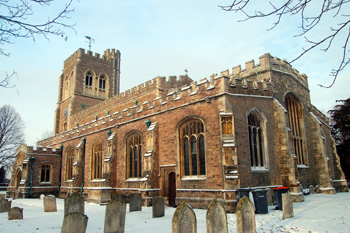
The church from the south-east on Christmas Eve 2010
Much of this article is taken from Bedfordshire Churches in the 19th Century: A-G by former County Archivist Chris Pickford and published in 1994 by Bedfordshire Historical Record Society. The church is, apart from the chancel, a 19th/20th century rebuild by architect George Highton. However, the church was much embellished in the 19th century by the Whitbread family and these monuments survive.
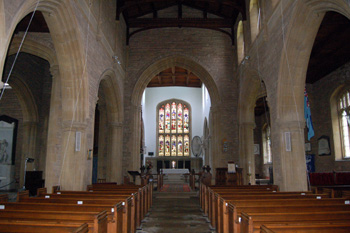
The interior looking east May 2010
Samuel Whitbread I was born in Cardington in 1720 and went on to found a brewery in London. This grew to become a nationwide brewing business before the company divested itself of all its breweries and licensed houses in 2002 to concentrate on hotels, restaurants and coffee shops. He was a rich man and gave a number of gifts to the church including a clock in 1760. Not to be outdone his kinsman, the philanthropist and prison reformer John Howard also donated a clock in that year!
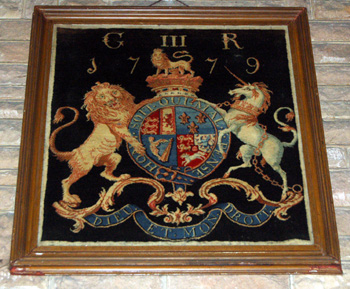
The royal arms of 1779 - May 2010
Whitbread also provided new altar linen and communion plate in 1763, the royal arms done in carpet work in 1779, a pulpit and reading desk about 1780, a sundial in 1782 and bells in 1772 and 1785. There are eight bells in total. Harriet Whitbread, his daughter, gave a font in 1783. Samuel also established a family vault in the church in 1791. Evidence also exists that Samuel restored and repaired the old church over a period from the 1760s to the 1780s.
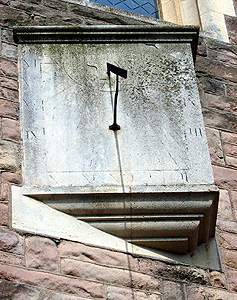
Sundial on the west wall of the west tower March 2011
This restoration included the fitting of box pews in the nave and chancel, whitewash on the walls and quarry glass in the windows. The Norman tower was also altered to give it a more Classical appearance in line with 18th century tastes. The roof of the south aisle was repaired between 1810 and 1812. Archdeacon Bonney in the 1820s though the church “remarkably neat and clean” one of the best three churches in the Diocese.
![The interior of cardington church looking east before restoration [Z50/24/48]](/CommunityHistories/Cardington/CardingtonImages/The interior of cardington church looking east bef.jpg)
The interior of Cardington church looking east before restoration [Z50/24/48]
As the 19th century went on the 18th century appearance of the church became increasingly unfashionable. WA, librarian of Woburn Abbey John Martin, wrote about the church in the Northampton Mercury on 30th January 1847: “The glare produced by the unsparing use of whitewash in this church is most unpleasant, and is in very little harmony with the solemn feelings which ought to accompany the spectator on his visit to a sacred edifice “.
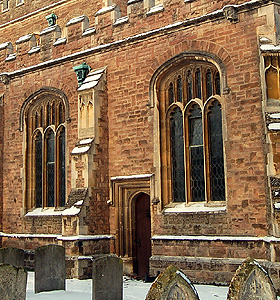
The south chancel door Christmas Eve 2010
“Anything but solemnity is engendered by this miserable daubing of the plasterer’s brush. The contrast is decidedly felt, if the visitor should have seen Warden church on the same day. The irreverent practice which is adopted here, as well as in many other churches, of admission by the chancel door, mars the general view, - never so well obtained as from the western approach. It is true that the chancel looks remarkably clean, as well as the whole of the building, from the whitewashing, but this might be obtained without, as in this instance, so stuffing up all architectural ornament as entirely to deprive them of their beauty. The railing round the altar is of very ordinary character, but good enough for the modern screen which faces it. There is a tablet with an inscription that it would be well to remove”.
“We have mural tablets, every size
That Woe would wish or vanity devise”.
“The chapel near the altar boarded off to hold a book case, wardrobe, and sundry other matters, has a ridiculous appearance, but we imagine it is a cheap substitute for a vestry. The chancel is disgraced by pews, and what must be seen with bitter indignation, the emblems of the pomp of heraldry are emblazoned on them [the royal arms]; - and in this sacred spot, whence the solemn warning that “we brought nothing into this world, neither may we carry anything out”, is constantly urged upon the congregation”.
“The nave has been most profusely whitewashed; there are a number of very high pews. The organ which would be better away in all churches of this size, does not interfere with the western window, but its situation, nevertheless, is very awkward. The door near to it has not the slight reference to a church door. A black marble basin serves the purpose of a font. Iron railings, of the commonest description, are placed round some monumental memorials; in a church so carefully guarded there can be no necessity for them. We are glad, however, to find the churchyard accessible, where the stranger might muse and mourn the waste of death”.
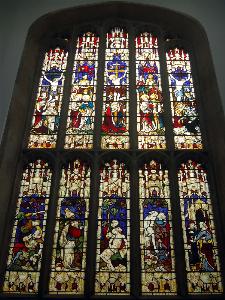
The chancel east window May 2010
The stained glass in the east window, by Clayton and Bell, was added in 1872. It is in memory of William henry Whitbread who died in 1867. The top half of the window depicts the Crucifixion and the bottom half shows scenes from the parable of the Good Samaritan.
![Cardington church during rebuilding [Z50/24/51a]](/CommunityHistories/Cardington/CardingtonImages/Cardington church during rebuilding [Z50-24-51a].jpg)
Cardington church during rebuilding [Z50/24/51a]
The reason for the rebuilding from 1897 to 1901 was the fact that structural problems arose with the tower, which lay in the centre of the church, between the nave and chancel. It was thought safer to take it down and build a replacement at the west end. Whilst this was being done the whole church, with the exception of the chancel was then rebuilt.
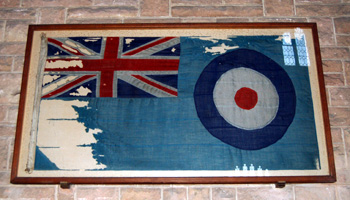
Flag from the R101 May 2010
Additions to the church in the 20th century include the tower clock of 1900, the organ, by J. and A. Trustram of Bedford, installed in 1901 and the R101 memorial of 1930, together with the flag flown from that unlucky vessel. A wooden lectern from a design by Professor Albert Richardson was installed in 1955. In 1982 the Bishop of Bedford dedicated the altar. It is a stone slab found in the churchyard and thought to be from the original church, discarded at the time of the Reformation. Crosses were cut into each corner before the 1982 dedication.

One of the incised crosses in the altar March 2011